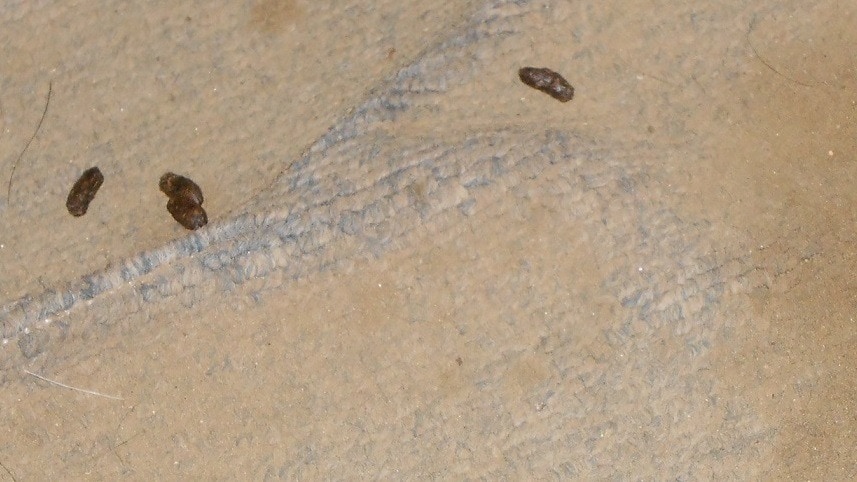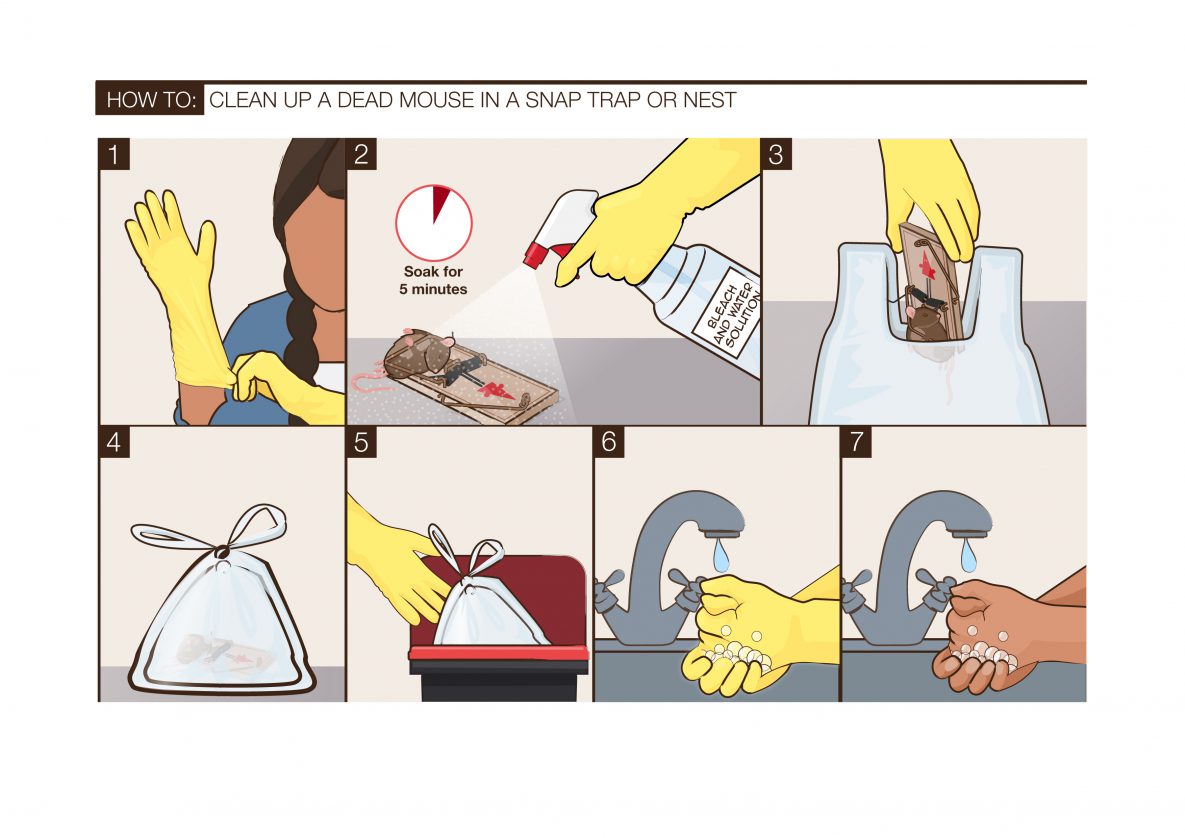Key points
- It's important to clean up all urine, droppings (poop), dead rodents, and nesting materials safely.
- Talk to a healthcare provider if you think a recent illness may be due to a rodent-borne disease. Tell them about any exposure to rodents.
- Contact your local health department if you have questions about your specific situation.

Prepare to clean up
Always take precautions when cleaning to reduce your risk of getting sick. Before you begin cleaning, prepare by gathering the proper equipment.
Use a preferred disinfectant
Use a general-purpose household disinfectant cleaning product or a bleach solution for disinfecting. Confirm the word "disinfectant" is included on the label of household disinfectants.
Alternatively, you can make a bleach solution. Combine 1.5 cups of household bleach in 1 gallon of water (or 1 part bleach to 9 parts water). Make bleach solution fresh before use.
Wear proper protective equipment
Wear rubber or plastic gloves. Additional precautions should be used for cleaning homes or buildings with heavy rodent infestation.
Do not vacuum or sweep rodent droppings
Clean up urine and droppings
Step 1: Put on rubber or plastic gloves.
Step 2: Spray urine and droppings with bleach solution or an EPA-registered disinfectant until very wet. Let it soak for 5 minutes or according to instructions on the disinfectant label.
Step 3: Use paper towels to wipe up the urine or droppings and cleaning product.
Step 4: Throw the paper towels in a covered garbage can that is regularly emptied.
Step 5: Mop or sponge the area with a disinfectant. Clean all hard surfaces including floors, countertops, cabinets, and drawers. Follow instructions below to clean and disinfect other types of surfaces.
Step 6: Wash gloved hands with soap and water or a disinfectant before removing gloves.
Step 7: Wash hands with soap and warm water after removing gloves. Use a waterless alcohol-based hand rub when soap is not available, and hands are not visibly soiled.

Clean up dead rodents or nests
Fleas are common on rodents. Consider using insect repellent on clothing, shoes, and hands while picking up dead rodents and cleaning up nesting materials. Using DEET or other EPA-registered repellents will reduce the risk of flea bites and minimize exposure to flea borne disease.
Step 1: Wear rubber or plastic gloves.
Step 2: Spray the dead rodent, nest, and surrounding area with a disinfectant. Let it soak for 5 minutes or according to instructions on the disinfectant label.
Step 3: Place the dead rodent or nesting materials in a plastic bag along with any used traps. Follow the steps below if you plan to reuse the trap.
Step 4: Tie the ends of the bag together in a knot to seal the bag. Place the full bag in a second plastic bag. seal the second bag by tying the ends together in a knot.
Step 5: Throw the bag into a covered garbage can that is regularly emptied. Alternatively, contact your state health department for information on other ways to throw away dead rodents.
Step 6: Wash gloved hands with soap and water or a disinfectant before removing gloves.
Step 7: Wash hands with soap and warm water after removing gloves. Use a waterless alcohol-based hand rub when soap is not available and hands are not visibly soiled.

If you plan to reuse the trap
Traditional snap traps can be reused.
If you plan to reuse the trap:
- Submerge the trap with the rodent in disinfectant (using a bucket) for 5 minutes while wearing rubber gloves.
- Remove the rodent from the trap by holding the trap over a plastic bag and lifting the metal bar.
- Let the rodent drop in the bag.
- Rinse the trap well with water to remove the scent of the disinfectant and let it dry completely.
- Follow steps 4-6 mentioned above by double bagging the rodent, disposing of the bag, and washing your gloves and hands.
Clean up different spaces
Homes and outbuildings like cabins, sheds, and barns
Prepare
- Open all doors and windows for 30 minutes before cleaning to ventilate the space. Leave the area during this time.
- Re-enter the area and look for rodent waste.
- Put on rubber or plastic gloves.
Clean
- Clean up all rodent urine, droppings, nests, or dead rodents.
- Mop hard floors or spray outbuilding dirt floors with disinfectant.
- Clean hard surfaces like countertops, cabinets, and drawers with a disinfectant.
- Move storage boxes and containers with potentially contaminated items outside to a well-ventilated area exposed to direct sunlight.
- Wash gloved hands with soap and water or a disinfectant before removing gloves.
- Wash hands with soap and warm water after removing gloves.
If exposed insulation is contaminated with urine and droppings, place it into plastic bags for removal.
Remove any potentially contaminated materials while outside. Remain upwind so any dust or debris does not blow toward your face. Discard any items that are no longer needed. Clean and disinfect any hard or nonporous items as recommended with a bleach solution or disinfectant.
Follow recommendations for other materials like cloth and paper. Dispose of any cardboard boxes contaminated with urine or droppings. Plastic, glass, or metal containers can be disinfected with bleach solution or disinfectant.
Use a waterless alcohol-based hand rub when soap is not available and hands are not visibly soiled.
Air ducts (heating and cooling ventilation systems)
Contact a professional rodent exterminating service to remove rodents when there is evidence, they have accessed heating and cooling ventilation systems. Companies specializing in duct cleaning are familiar with the problems and risks associated with rodent infestation in ventilation systems.
How to Inspect and Disinfect a Vehicle

Rodents may build their nests in cars, trucks, campers, and other vehicles, especially if such vehicles are used infrequently. Check and clean your vehicle to prevent the spread of rodent-borne diseases. Consult a qualified mechanic or automotive professional for assistance.
While the vehicle is in a well-ventilated space, you should inspect for rodent activity. Detect any waste, nests, or dead rodents and disinfect to clean the vehicle.
Inspect
Open the hood, vehicle doors, and trunk to allow the interior and engine compartment to air out for 20 minutes.
When starting a vehicle that has been idle for an extended period, air it out first. Inspect the air intakes and filters before starting the engine. Check inside the vehicle interior. Remove cables from the battery to avoid shock before inspecting the engine compartment.
Be sure to wear plastic gloves and a long-sleeved shirt.
Detect
Find any dead rodents, nesting materials, or rodent waste (like urine or droppings). Gather cleaning supplies to clean and disinfect.
Disinfect
- Do not use a vacuum or high-pressure sprayer on rodent urine, droppings, or contaminated surfaces until they have been disinfected.
- Spray materials with a disinfectant until fully soaked and let sit for 5 minutes or according to label instructions.
- Use a paper towel to pick up the materials and dispose of the waste in the garbage.
- After the rodent droppings and nesting materials are removed, clean the rest of the area with additional disinfectant.
- Reconnect the battery when the area is dry.
- Wash gloved hands with soap and water or a disinfectant before removing gloves.
- Wash hands with soap and warm water after removing gloves.
If you find nesting materials in the air intake system, remove both the nesting materials and the air filter. Discard nesting material in the garbage. Insert the new replacement filter and close the unit.
Preventing future infestations
Prevent future colonization of vehicles. Rodents can enter the passenger compartment through ducting, rusted areas, and cable conduit. Snap traps and poison baits are effective in stopping rodents access into vehicles. Do not leave any kind of food anywhere in the car, as it can attract rodents.
Cleaning and disinfecting surfaces
Porous and non-hard surfaces require different methods for cleaning and disinfecting. These steps should be followed after rodent urine and dropping have been sanitized and removed (in the case of droppings).
Clothing, bedding, and stuffed animals
Launder potentially contaminated bedding, clothing, or stuffed animals with hot water and detergent. Machine dry on a high setting or hang to air dry in the sun.
Carpets and upholstery
Shampoo rugs and upholstered furniture with a commercial disinfectant or with a commercial-grade steam cleaner or shampoo.
Books, papers, and other non-washable items
Leave books, papers, and other items that cannot be cleaned with a liquid disinfectant outdoors in the sunlight for several hours. This includes items like books and papers. They can also be left in an indoor area free of rodents for a minimum of three weeks. A longer period of six weeks is strongly suggested).
Special precautions for heavy rodent infestation
Special precautions should be used for cleaning homes or buildings with:
- Heavy rodent infestation.
- Vacant dwellings with large numbers of rodents and to dwellings.
- Structures with confirmed rodent spread diseases in rodent population.
Special contacts
Workers hired specifically for clean-up or are asked to do so as part of their work activities should contact:
- Their local or state health department.
- Their local or state occupational health and safety authority (OSHA).
- CDC for information about preventing rodent-borne diseases.
Personal protective equipment
People involved in the clean-up of heavy rodent infestations should wear appropriate personal protective equipment (PPE):
- Coveralls (disposable, if possible)
- Rubber boots or disposable shoe covers
- Rubber, latex, or vinyl gloves
- Protective goggles
- Appropriate respiratory protection device
Appropriate respiratory protection includes a half mask air-purifying (or negative-pressure) respirator with a high efficiency particulate air (HEPA) filter. A powered air-purifying respirator (PAPR) with HEPA filters can also be used.
Follow local and state requirements regarding pulmonary function and fit testing before beginning any work requiring the use of a respirator.
PPE should be decontaminated upon removal at the end of the day.
